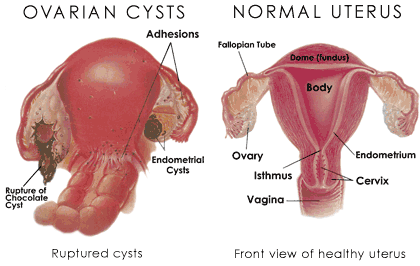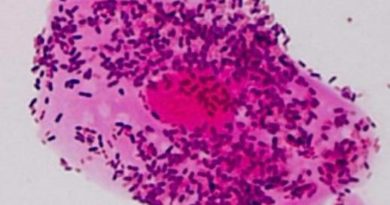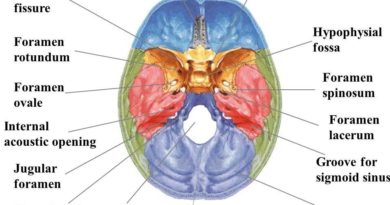Hemorrhagic Cyst
What is Hemorrhagic Cyst?
Hemorrhagic Cyst is a lump of tissue-like structures formed in the ovaries of a female human body when bleeding occurs into the follicular or corpus luteum. When this happens, it results in a condition referred to as a hemorrhagic ovarian cyst.
Development of such cysts is common and do not result in harmful symptoms in normal cases.
However, it is important to seek medical attention if you experience gradual pains during your menstrual period or during sex to avoid maturity of possible cancerous cells. 1,2

Risk Factors
The probability that you may develop this kind of cyst may depend on many factors:
- If you have experienced related problems before and they were or not treated. Cysts are most likely to reoccur and hence if there is a cyst history, you should have regular checkups of the same.
- Ovarian cysts are likely to affect people who have irregular menstruation. This is a case where cycle may take a longer or shorter period than normal and sometimes you might skip a month or two. In both cases menstrual flow may be very heavy and with blood clots indicating a possibility of a cyst.
- Ovarian cysts may be experienced in people with fertility issues and may result to development of cancer cells if not detected early enough
- If you are a victim of polycystic ovarian syndrome which is due to failure of the ovulation process from taking place, there is a high risk of developing ovarian cysts which might be life threatening
- Overweight and obesity are part of the major contributors to ovarian cysts due to the extra tissues and fat that may form along the ovaries.
- Menstruation varies among women as there are those start at a very young age while it comes at an older age in others. Those who begin at very young age have the potential of developing ovarian cysts.
- These cysts may also develop as a result of breast cancer therapies. This could be as a result of the medications used by the patients such as tamoxifen, which contributes to growth of cysts.
- Hyperthyroidism cases may also contribute to formation of such cysts
- Endometriosis, which is the formation of tissue on the surface of uterus and ovaries, is a major cause of ovarian cysts.
Types of Ovarian Cysts
Ovarian cysts are broadly classified into two:
Functional cysts
These are the most common and in rare cases do they form as a result of cancer. They may include:
- A follicle cyst– whose formation follows a collapse of mature follicles or failure of the ovulation process. They can however result to pain in case of rupture.
- A corpus luteum cyst– this forms when the opening of a follicle closes especially after ovulation trapping in some fluid
- A hemorrhagic cyst- that is as a result of bleeding.
Nonfunctional cysts
There are several nonfunctional cysts of the ovary and they include:
- An endometrioma- this forms tissues that later attach to the uterus as a result endometriosis process.
- A cystadenoma– this is a fluid filled sac occurring on the outer part of ovaries. It can grow and cause pain. Those that contain thick mucus are referred to as mucinous while serous cystadenoma contains thin fluid.
- Teratomas or Dermoid cysts- these may consist of hair, tissues and fat and are formed on the ovaries
- Polycysts- they form as a result of ovulation not taking place.
How do Hemorrhagic Cyst Look like?
It is possible to check the appearance of these hemorrhagic cyst, especially when an ultrasound is performed. The appearances may differ depending on the different stages and formation period.
- They can take the shape of a fishnet or form a fine reticular pattern especially if the fibrin material has strand like structures.
- They may also have are tracting clot appearance as a result of blood clotting occurring in an inhomogeneous manner.
- Sedimentation of material during the hemorrhagic process may result the cyst appearing like a fluid of debris within the ovary.
- They may appear ruptured, especially if there is blood along the pelvic region and there might be a risk of ectopic pregnancy in this case.
- It might take the shape of a solid ovarian neoplasm due to the presence of echogenic material during the clot formation stage
Symptoms
Although ovarian cysts are normal when they occur, they might be accompanied by various symptoms which may create alarm for ovarian cancer and other reproductive health issues. These symptoms may include;
- Abdominal pains accompanied with bloating or swelling in the lower stomach
- Cases of bleeding in between periods and irregular cycle changes
- Lower back pains and also inner thighs
- Breast tenderness
- Nausea or vomiting
- Painful sexual intercourse
- Difficulties in bowel movement
- Sharp pelvic pain prior to and during menstrual cycle
A close attention should be paid to any kind of symptoms before they mature to a more serious stage. In the case of increased breathing, sharp and sudden pelvic pains, dizziness and fainting, it is necessary to seek immediate medical attention. At this stage, there could be rapture on the cysts which may pose major health implications.

Diagnosis
It is important to go for testing to determine whether there could be possibilities of ovarian cysts developing, especially if you experience the afore mentioned symptoms. The process may include various tests:
1.Pelvic and transvaginal ultrasound
Examination of the pelvis allows for viewing of the cyst’s movement and observing its sound waves. This can hence help in determining the constituents of the cyst either solid tissues, fluid or both.
On the other hand, a transvaginal ultrasound provides more details of the same since it involves a probe insertion into the vagina for uterus and ovary examination.
2.Laparoscopic surgery
This involves identification and removal of the cyst whereby; an incision is made on the abdomen to allow a laparoscope to pass through into the ovaries and pick out the existing cyst.
3.Serum CA-125 Assay
This test is performed to identify the underlying causes of the cyst. If cancer is suspected, an antigen is used alongside a blood sample and if the level of CA-125 rises, then there could be potential of ovarian cancer.
However, the rise in level can be due to other factors such as fibroids and endometriosis ruling out the cancer. It’s therefore not reliable when it comes to cancer of the ovaries.
4.Hormone levels
Pregnancy and blood tests can be performed to check for hormones responsible for polycystic ovarian syndrome and possibilities of cancer cells.
5.Culdocentesis
This involves insertion of a needle through the vagina to pick samples of the pelvic fluid which is then examined to ensure there is no leakage in the abdominal cavity. Presence of bleeding may result to clot formation which may eventually mature into cysts.
Treatment
Since there is no specific treatment for many cases of ovarian cysts, it is recommended that you visit your doctor regularly to check for any possible changes in size of the cyst. This is referred to as “watchful waiting.”
Surgery
Depending on the cyst size and potential of malignancy, various surgical procedures may be used to remove the cysts. Surgery may be a preferred option if:
- The cyst fails to go away and continues to grow large in size
- The doctor suspects cancer in relation to the cyst during an ultrasound
- You experience a lot of abdominal pain and your periods irregular
- You are past menopause and at the risk of cancer.
Medications
For cases where you are a victim of functional hemorrhagic cyst, prescriptions may be given by your doctor to help prevent ovulation and new cyst formation.
In this case the doctor can recommend the use of hormonal birth control pills. Similarly, anti-inflammatory and pain killers such as ibuprofen can ease up the abdominal pains.
Reference List
- hemorrhagic cyst ovary. Retrieved from http://allcoastobgyn.com/wp-content/uploads/2011/10/OVARIAN-CYSTS-revised.pdf
- Hemorrhagic Ovarian Cyst: A Sonographic Perspective. Retrieved from
- http://www.obgyn.net/obgyn-ultrasound/hemorrhagic-ovarian-cyst-sonographic-perspective
- Ovarian cysts: types, symptoms and treatment- health line. Retrieved from
- http://www.healthline.com/health/ovarian-cysts?m=0#treatment6
- What Are hemorrhagic cyst? Symptoms, Types and Treatment- On Health. Retrieved from http://www.onhealth.com/content/1/ovarian_cysts


